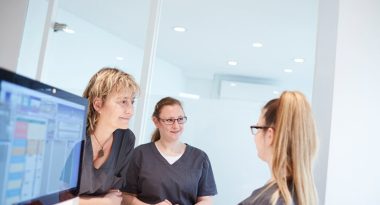The challenges of creating the big picture
The folder “Professional Management” is still in the cupboard behind Andreas Hager’s desk. The systematic organization of a dental clinic has been a constant topic for the trained dental technician and dentist since the day the clinic was taken over 20 years ago. At the same time, especially in smaller companies, it is important to keep it simple and not to overwhelm the employees with theory and bureaucracy.
Andreas Hager and his well-rehearsed team have tried out some approaches to QM & Co. and, for example, have put special software into operation or introduced management systems in a targeted manner. Unfortunately, despite reasonable efforts, it was never really finished: The systems remained isolated individual solutions and were not maintained. The effort was very high, but the benefit did not really appear. Accordingly, motivation and acceptance among those involved were low. It just didn’t round it up.
An important point in previous attempts has always been the exchange of information: content such as specifications or resolutions must be sustainable and easy to find at any time. The size of the team is also irrelevant: whether 8 or 80 people affected do not have access to crucial information always has the same negative effect on quality.
Andreas Hager and his wife Martina, who works in the clinic accounting, became aware of medikit during a further training course as part of the prestigious Dentist Entrepreneur Workshops (ZUW), and the hope grew that it could behave differently due to the innovative platform concept.
Against it first
The first impression of medikit as a modern, cloud-based web application was very positive. In fact, Andreas and Martina Hager decided against a medikit test for the time being. Cloud software is rented – this is transparent and the costs are understandable, but it is unusual not to own software and to have running costs instead.
However, the ongoing, daily challenges in everyday practice have not let the topic calm down. After careful consideration, dentist Hager decided to take a test month and even risked the house blessing: The chance to summarize the entire individual piece and no longer had a folder for every topic (QM, hygiene, repairs, etc.) that was never used anyway to tempt. A decisive aspect in this decision was of course that the test was absolutely risk-free because it was non-binding and did not involve any additional costs.
We use medikit as a sort “clinic wikipedia”. The system enables us to centrally manage all information documents required today, such as hygiene plan, employers liability insurance association, job descriptions, work instructions, quality management, error management, X-ray regulations and GDPR. In addition, an effective control of repair measures is possible. medikit’s internal communication options also open up the ability to collect or pass on tasks, ideas and planning processes without paper. A round thing!
Their success
After just 3 months medikit has become an integral part of everyday practice. The helpful functions in connection with the ongoing commitment of the compact team enable a QM and practice organization system from a single source.
Digital handbook
With medikit around 800 knowledge articles were created in a very short time – an astonishing peak value that puts many large clinics in the shade. This shows that systematic knowledge management does not depend on the size of the company. The team quickly got used to having any form of exchange flow into a form of documentation. Sometimes e.g. the need for a new work instruction from a chat as part of the error management shown in medikit. This is then generated with a few clicks from what has just been discussed and is automatically known to all employees concerned within a very short time. In general, it is perceived as particularly positive that a lot is now made comprehensible in writing and nothing can be forgotten. The search function in medikit, which rummages through all the content from the manual to comments and calendar entries is particularly helpful in this context.
More efficient communication
Contrary to the occasional misgivings given the size of the team, the communication culture benefited surprisingly from the use of medikit. In everyday practice, relatively mundane communication content, such as the processing of repair jobs, takes up too much space in relation to its importance. After it was possible to relocate especially the topics for which personal conversation is not necessary into medikit through automated processes such as repetitive tasks and checklists, that there was actually more time for the important conversations.
Another positive aspect is the possibility to deal with content with a time delay. For example, topics for the regular team meetings are collected in advance using the ideas tool in medikit. The colleagues come to the meeting prepared and in the mood. The productivity of these sessions could so be noticeably increased again.
Control and security
Perhaps the most important aspect for Andreas Hager is the perceived feeling of security and procedural control. Functions such as repetitive tasks, e.g. the semi-annual filter change for the compressor in the basement is recorded once and the owner can be sure that he will be reminded. Another issue that worried the entrepreneurial clinic owner was the risk of loss of service providers. The regular operation was entirely dependent on the central colleagues, who had very detailed, but largely undocumented process knowledge. In the event of a failure, nobody would have an overview. The systematic documentation of the most important processes enabled this dependency can be significantly reduced.






